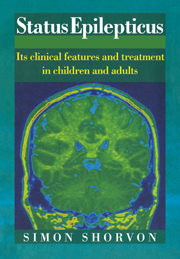Book contents
- Frontmatter
- Contents
- Preface
- 1 The concept of status epilepticus and its history
- 2 Definition, classification and frequency of status epilepticus
- 3 Clinical forms of status epilepticus
- 4 Neurophysiology, neuropathology and neurochemistry of status epilepticus
- 5 Emergency treatment of status epilepticus
- 6 Prognosis and outcome of status epilepticus
- References
- Index
1 - The concept of status epilepticus and its history
Published online by Cambridge University Press: 15 September 2009
- Frontmatter
- Contents
- Preface
- 1 The concept of status epilepticus and its history
- 2 Definition, classification and frequency of status epilepticus
- 3 Clinical forms of status epilepticus
- 4 Neurophysiology, neuropathology and neurochemistry of status epilepticus
- 5 Emergency treatment of status epilepticus
- 6 Prognosis and outcome of status epilepticus
- References
- Index
Summary
If the possessing demon possesses him many times during the middle watch of the night, and at the time of his possession his hands and feet are cold, he is much darkened, keeps opening and shutting his mouth, is brown and yellow as to the eyes… It may go on for some time, but he will die.
(XXV—XXVIth tablet (obverse) of the Sakikku cuneiform, 718/612 BC)Pre-history of status epilepticus
Epilepsy, that unrivalled hierophant of neurology, has an ancient pedigree. The Sakikku cuneiform is the earliest known record, and there, with due foreboding, is the first allusion to status (fig. 1.1). Surprisingly, though, in the long line of historical reference to epilepsy which followed, status received scant attention. No condition resembling status was recorded by Hippocrates in the fourth century BC in his great work on epilepsy, nor by Galen in the second century. The fifth-century Numidian, Caelius Aurelianus, gave a grave prognosis to protracted epileptic attacks ‘which extended into a second day’, but there was little other mention of prolonged seizures in the classical literature. Mediaeval medicine left status undisturbed, although epilepsy was extensively described because of its demoniacal associations. In renaissance times there were sporadic reports:
the illustrious cardinal Commendoni suffered sixty epileptic paroxysms in the space of 24 hours, under which nature being debilitated and oppress'd he at leangth sank, and died. His skull being immediately taken off, I found his brain affected with a disorder of the hydrocephalous kind.
(Gavassetti 1586)- Type
- Chapter
- Information
- Status EpilepticusIts Clinical Features and Treatment in Children and Adults, pp. 1 - 20Publisher: Cambridge University PressPrint publication year: 1994
- 4
- Cited by



